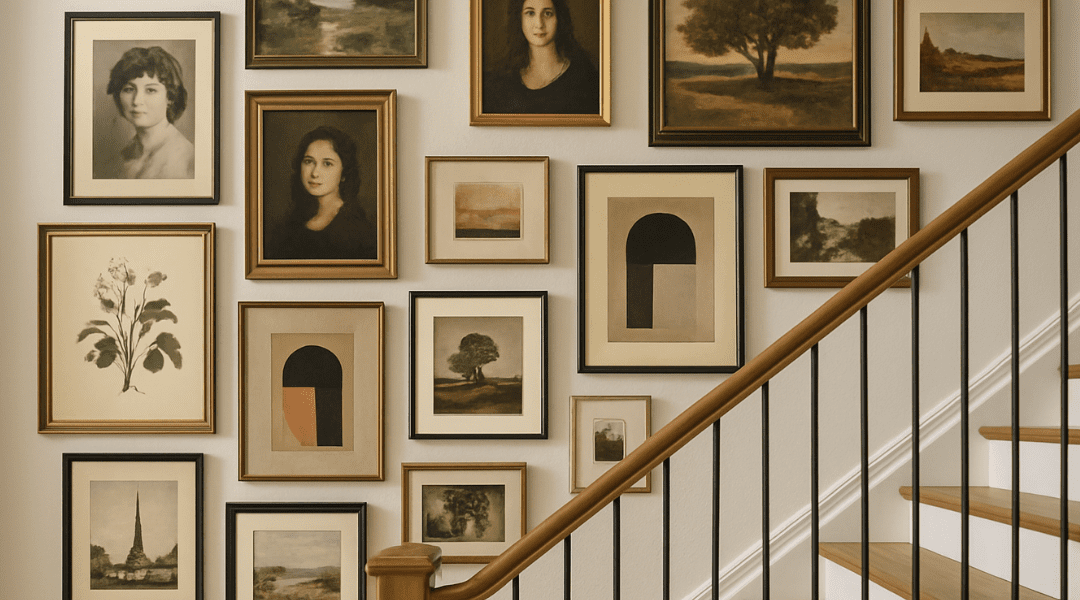In the span of a week, I had three different people reach out asking the same thing: “What should I do with my staircase wall?”
It’s a question I hear more often than you’d think—and honestly, it’s one of the most overlooked design opportunities in a home.
I’ll admit, I haven’t talked much about stairway walls before. I’ve spent all of my adult life living in apartments and condos, where stairs just aren’t part of the equation. But over the years, I’ve helped plenty of clients tackle this exact design dilemma, and one thing is clear: your staircase wall has major potential.
It’s a vertical stretch of space that’s right in your line of sight, usually connecting your most-used floors. And yet, it’s often left bare—or worse, treated like an afterthought. But when you decorate it with intention? It becomes a quiet showstopper. One of those “oh wow” moments that makes your home feel elevated, cohesive, and personal.
In this post, I’m sharing my three favorite ways to decorate a staircase wall—ideas that I return to again and again because they work. Whether your style is bold, minimal, modern, or traditional, these will help you turn that blank wall into something beautiful.
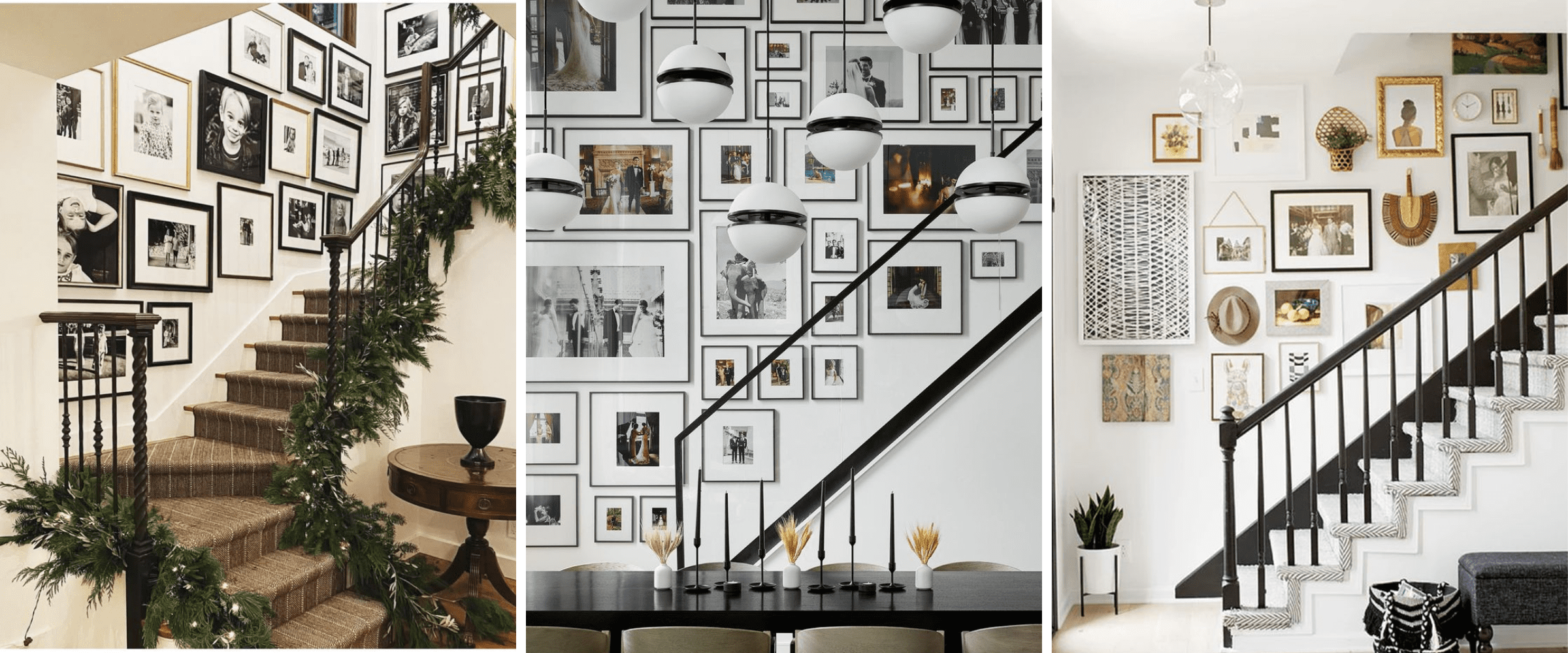
Images via Pinterest.
1. The Classic Gallery Wall
A gallery wall along the staircase is one of those timeless decorating ideas that just works. It adds personality, tells a story, and makes that in-between space feel intentional instead of ignored.
But here’s the thing: gallery walls can go wrong fast if they’re not planned properly—especially on a staircase, where the angles and flow of movement make things a little trickier.
The key is to follow the rise of the stairs. Your layout should mimic the angle of the staircase so it feels cohesive and not chaotic. Start by mapping it out on the floor or using painter’s tape on the wall before committing to nails.
But before you get to the mapping stage, pause and ask yourself a few important questions.
Do you want something clean and minimal—maybe 3 to 5 large prints spaced evenly along the wall? Or are you envisioning something more layered and eclectic, like a collected-over-time mix of artwork, family photos, and vintage finds?
Next, think about your frames. Do you want them to all match for a polished, uniform look? (Think all black or white frames in the same style.) Or do you prefer a mix of colors, materials, and sizes for a more relaxed, curated feel?
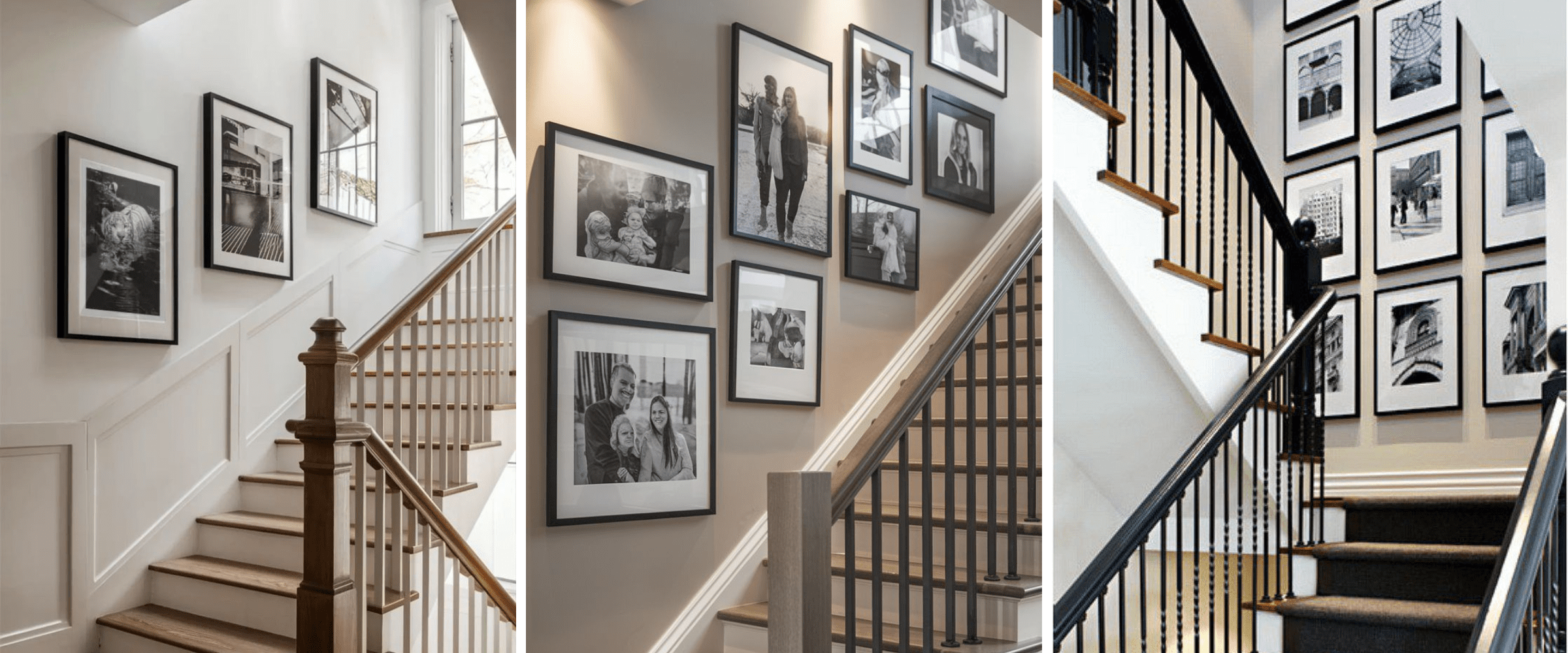
Images via Pinterest.
And most importantly—what kind of content do you want to showcase?
Are you highlighting family memories? Abstract art? Travel photos?
There’s no right or wrong answer, but your choices here will set the tone for how the whole thing comes together.
Just make sure it reflects you—because a gallery wall should feel personal, not like you copied a Pinterest board.
And here’s one pro tip: Don’t start too high. I see this all the time—art that floats way above eye level. You want the center of your frames to be roughly 57–60″ from the steps they’re anchored to, so they stay connected to the space instead of drifting off into no man’s land.
Done right, a staircase gallery wall becomes more than just decoration. It’s a visual timeline. A moment of pause as you move through your day. And most importantly—it makes your home feel like yours.
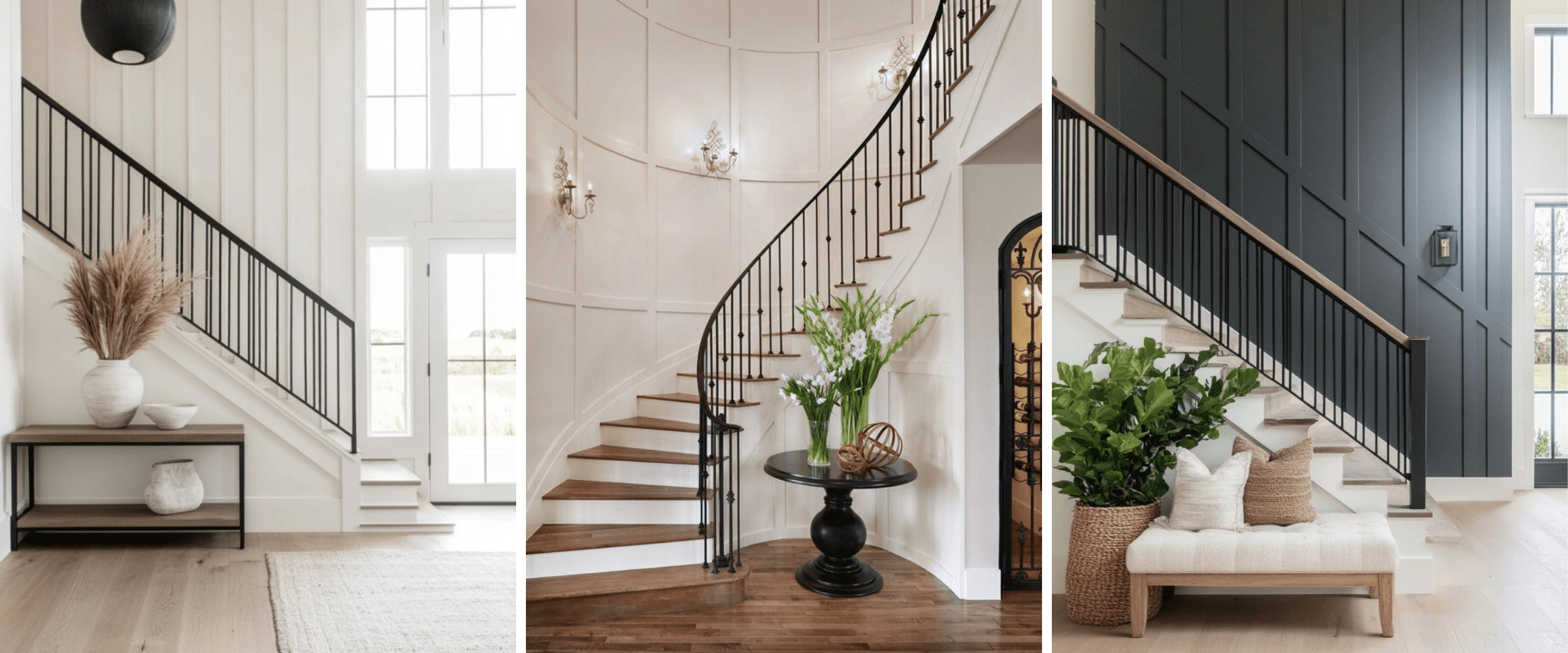
Images via Pinterest.
2. Wall Paneling for Instant Elevation
This is hands down one of my favorite ways to decorate a staircase wall. If you do it right, wall paneling can instantly elevate the entire feel of your home. It adds depth, dimension, and a sense of intention—even if the rest of the wall stays perfectly minimal.
What I love most about paneling is that it works with the architecture instead of just sitting on top of it. It gives the wall structure and visual rhythm, which is especially important on a staircase where the angles and height changes can feel a bit disjointed without something to ground them.
And the options are endless. You could go classic with board and batten, keep it clean and simple with vertical slats, or go bold with large-scale grid paneling for a more contemporary vibe. Even just a simple picture frame moulding can completely transform the wall and make it look like it belongs in a custom-designed home.
The key is proportion.
Let the wall speak. Consider how tall your ceilings are, how wide the staircase is, and what’s happening in the rest of your home. You want the paneling to feel balanced—not too busy, not too sparse. And don’t forget about paint! Paneling looks beautiful in a crisp white or soft neutral, but it’s also a great opportunity to introduce a moody, saturated tone if your home can handle a little drama.
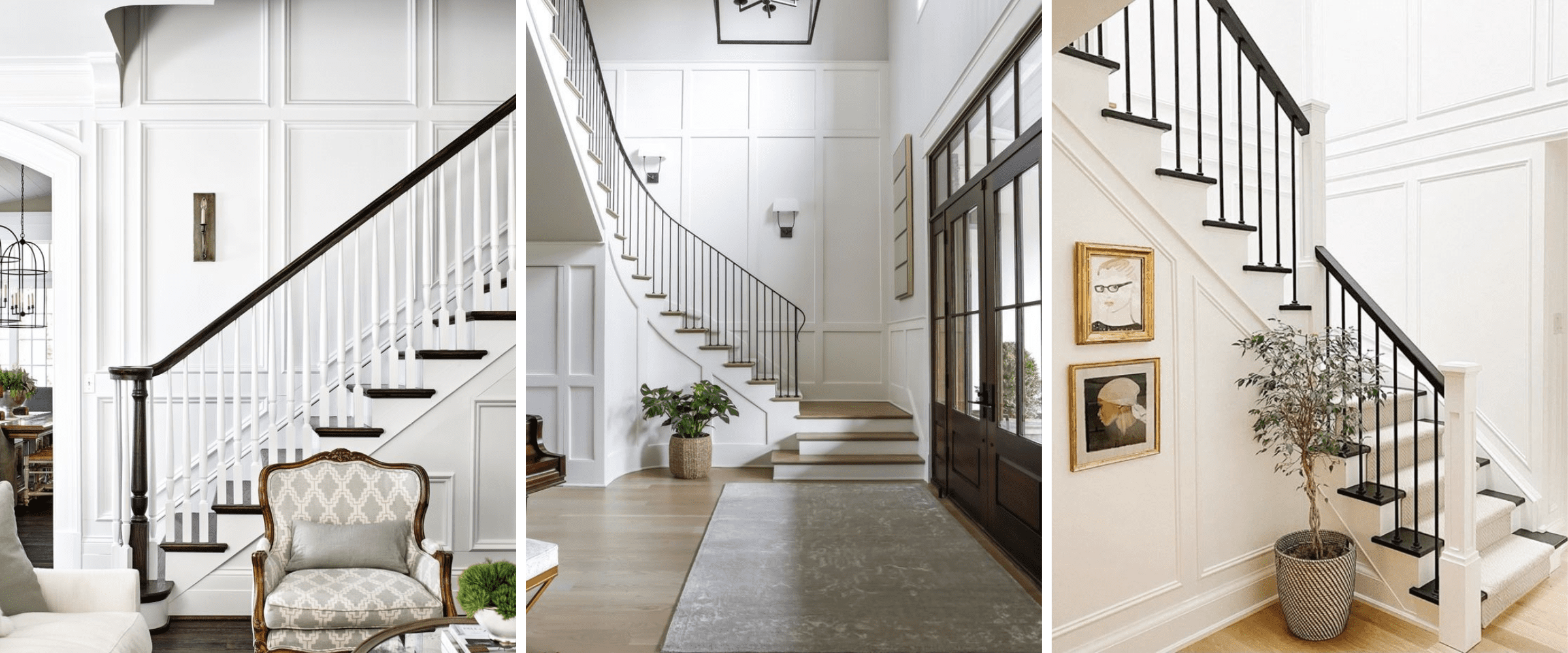
Images via Pinterest.
If you really want to take it to the next level—especially if you’re after a more contemporary or high-end look—think about how you can incorporate lighting into the paneling. Wall sconces that align with the vertical lines of your paneling, integrated LED strips tucked into the moulding, or even recessed lighting above the staircase can add a soft glow that brings warmth and texture to the space at night.
Lighting does more than just illuminate—it casts shadows, highlights the texture of the paneling, and adds that layered, designer feel you see in magazine-worthy homes. It’s one of those finishing touches that most people skip—but when it’s done well, it makes the space feel rich and considered.
If you’re someone who prefers a more minimal or classic look over a busy gallery wall, paneling can be your best friend. It brings in character and detail without the need for artwork or accessories. In fact, I’ve worked on homes where we did just paneling on the stair wall—and it was enough to make the whole space feel designed and elevated.
Done right, it’s one of those design elements that people might not even be able to name, but they’ll definitely feel the difference.

Images via Pinterest.
3. Wallpaper That Makes a Statement
If you want your staircase wall to turn heads (in the best way), wallpaper is your secret weapon. It’s one of those design elements that can completely transform a space without adding more furniture, art, or accessories—and it works especially well in staircases, where the wall often stretches up through multiple levels.
Wallpaper is a chance to bring in color, pattern, texture—or all three—depending on the look you’re going for. Want something bold and graphic? Go for a large-scale print or geometric pattern. Prefer something subtle and timeless? A tone-on-tone grasscloth or soft botanical can add just the right amount of interest without overwhelming the space.
One thing I love about wallpaper in stairwells is that it does the heavy lifting. You don’t need to hang art or fill the wall with anything else if the paper itself is doing the talking. And because staircases are transitional spaces (you’re usually just passing through), they’re the perfect place to take a bit of a design risk. You can go a little bolder than you might in a main living area, and it’ll still feel balanced.

Images via Pinterest.
A few quick tips:
- Choose a pattern that works with the scale of your space. Smaller prints can get lost in tall stairwells, while large prints can feel overwhelming in tight, narrow ones.
- If your staircase wraps around a corner or goes up multiple floors, consider how the pattern will flow from one wall to the next. A mural-style wallpaper or vertical stripe can help visually stretch the space.
- Removable wallpaper is a great option if you’re not quite ready to commit, especially for upper staircases that aren’t seen as often.
And if you really want to elevate the look? Pair your wallpaper with wainscoting or lower wall paneling. The contrast between a patterned upper wall and a crisp, clean base creates instant depth and sophistication.
Wallpaper isn’t just for feature walls in bedrooms or powder rooms—it’s perfect for staircases. It turns a pass-through area into a major design moment. A conversation starter. A design detail that makes your whole home feel more stylish.

Images via Pinterest.
Final Thoughts
Your staircase wall doesn’t have to be just a blank space you walk past every day. Whether you go for a meaningful gallery wall, classic paneling, or a bold wallpaper moment, the key is to choose something that feels like you. Something that connects with the style of your home and adds that extra layer of intention and beauty.
You don’t need a big budget or a grand foyer to make a staircase wall feel special. You just need a plan—and a little inspiration.
If you’re feeling stuck on what would work best in your home, or you’ve been staring at that blank wall for months wondering where to start, I can help. Book a Room Rx session and I’ll give you personalized, professional advice on how to turn your staircase (or any room, really) into a space you actually love walking through.

